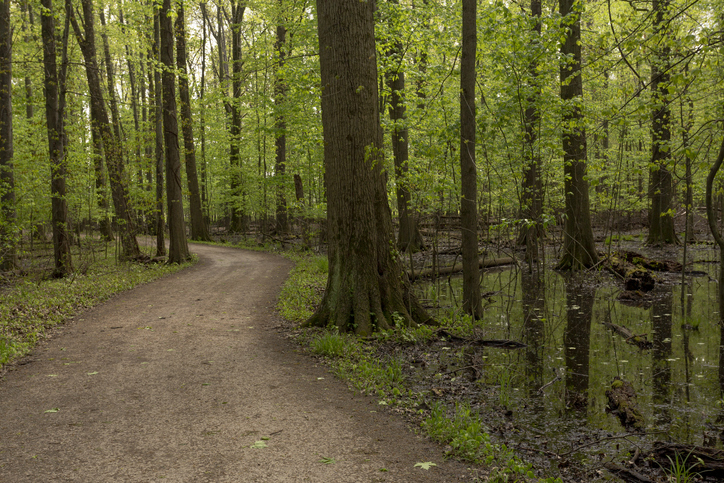Join the Critical Fight to Divert Solar Projects from Forests
June 10, 2022
Rhode Island needs forests, and renewable energy, to fight climate change.
However, forest loss from solar development is working against our carbon-reduction mandates in the Act on Climate.
Sixty-nine percent of all forest loss in Rhode Island is from solar development, according to the Department of Environmental Management (DEM). From 2018 to July 2021, Rhode Island lost 1,041 acres to ground-mounted solar development, almost 10 times more than any other land use. It is counterproductive to have state laws that subsidize the destruction of forests when they are clearly needed to comply with the Act on Climate law.
Thanks to the leadership of state Rep. June Speakman, House bill H7531 Sub A would make our state’s most important forests ineligible for incentives to develop renewable energy. This will not prevent solar development in all forests, only in undeveloped forests that are 250 acres or greater, identified in the Rhode Island Wildlife Action Plan as the most important to conserve. But it also defines preferred sites — landfills, gravel pits, brownfields, carports, commercial and industrial zones, and rooftops — where renewable energy should be focused. Moreover, the bill provides the authority to establish disincentives to discourage renewable energy development in non-preferred sites. If adopted, this legislation would be a huge improvement to Rhode Island’s current renewable energy siting programs, which are behind Massachusetts and Connecticut in employing effective strategies to prevent forest loss.
To be successful in the fight against climate change, Rhode Island must achieve two broad objectives simultaneously. First, the state needs to eliminate carbon emissions ASAP. The second objective, which is just as important as the first, is to remove and store the massive amounts of carbon that have already been released into the atmosphere. Renewable energy addresses the first objective but, unlike forests, can’t remove or store carbon.
The U.S. Climate Alliance has determined that as the impacts of climate change continue to intensify, it is essential that we safeguard and enhance the capacity of forests and natural lands to absorb and store carbon. The General Assembly, in the 2021 Forest Conservation Act, determined that forestland has many important values, including, but not limited to: clean air, clean water, economic importance, climate-change mitigation, habitat, and supporting human health and well-being. Forestland should be maintained to meet Rhode Island’s aggressive climate-change goals.
The good news is that the Ocean State can meet its renewable energy goals without sacrificing our forests.
A 2020 study entitled Solar Siting Opportunities for Rhode Island analyzed developed and disturbed site, including rooftops, landfills, gravel pits, brownfields, commercial/industrial, and carport solar. This study found there was the potential on these developed/disturbed sites to site solar that could eliminate as much as 70% of Rhode Island’s total, current greenhouse gas emissions. Moreover, offshore wind has been determined in a 2020 study by the Brattle Group to be more cost-effective than land-based, utility-scale solar. Therefore, the majority of the state’s renewable energy will likely be generated by offshore wind and the remainder can be solar sited on developed and disturbed sites.
This bill has had tremendous support, with 294 people testifying in favor, two in opposition, and two more expressing some concerns that were addressed in the revised bill. For all these reasons, it is imperative that H7531 Sub A be adopted this year. Next year is simply too late! Please support this bill by contacting your legislators.
Scott Millar is the director of conservation and community assistance at Grow Smart Rhode Island.




If Rhode Island CAN meet the renewable goals WITHOUT cutting down forests, why the 250 acre minimum for protection? That’s why I didn’t like the wording of the bill.
Robert,
The 250 acres of undeveloped or core forest was selected since it was determined by DEM to be the most important to conserve. The core forest is approximately 20% RI’s land area. MA and CT have already adopted similar approaches. The bill also defines preferred sites where solar development should be targeted and gives the authority to develop further economic disincentives to discourage development in non-preferred sites. If the eligibility for renewable energy was eliminated for all forests the bill would never be adopted.
Forests capture and sequester existing carbon from the atmosphere. Solar panels limit adding additional carbon to the atmosphere. Cutting down trees to install solar panels does nothing to mitigate carbon already accumulating from other sources. It simply limits the amount of carbon being added from a specific source, ie; power generation. If forests are removed there is nothing left to absorb carbon from all other sources. The net result is carbon accumulates and we fall farther behind on the goal of reducing greenhouse gases. We need to keep all forests and relegate solar to rooftops, parking lots and otherwise impaired sites. To do that we need to make it uneconomical for developers to use forested, open space and farm areas. The best way to do that is to remove any and all incentives from any project in those areas while at the same time increasing incentives for the other sites.